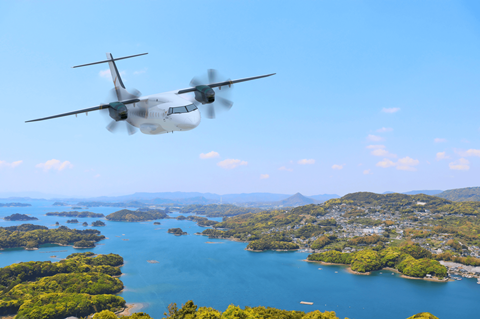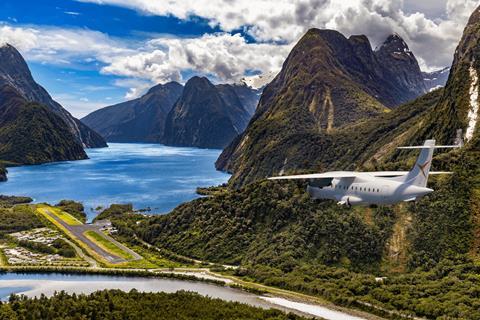Deutsche Aircraft is targeting Canadian airlines for sales of its in-development D328eco turboprop, pitching the type as an ideal replacement for hundreds of ageing regional aircraft now plying Canadian skies.
“Canada is one of the most-important regional aviation markets in the world. It’s a prototype for what regional aviation is,” says Deutsche Aircraft sales director Nils Heuer. “This market needs a state-of-the-art, 21st century regional aircraft… There will be a huge potential.”
Heuer last week attended the Air Transport Association of Canada’s annual conference in Vancouver, part of a push by the aircraft developer to drum up interest in a modernised and stretched variant of the original D328 turboprop. Deutsche Aircraft, a division of US firm Sierra Nevada, owns type-certificate rights to the D328, which had originally been produced by Dornier.

Powered by twin 2,475shp (1,846kW) Pratt & Whitney Canada (P&WC) PW127XT-S turboprops, the 40-seat D328eco is to cruise at 324kt (600km/h), fly up to 30,000ft and have 655nm (1,213km) of range. The aircraft will have advanced Garmin G5000 avionics.
Deutsche Aircraft, based in Oberpfaffenhofen near Munich, has delayed the project twice, most recently earlier this year when it pushed service entry to late 2027, citing certification requirements.
“We are also using this delay now to improve the aircraft,” Heuer tells FlightGlobal, citing changes related to short take-off and landing performance and to avionics. He is not more specific.
Canada is a uniquely opportunistic market for any new turboprop owing to its vast geography and abundance of sparsely populated cities.
While airlines in the USA have largely phased out passenger turboprops in favour of regional jets, Canadian carriers still make significant use propeller-driven types, operating 52 ATRs and 214 De Havilland Canada Dash 8s, according to aviation analytics company Cirium.
Air Canada affiliate Jazz, Porter Airlines and WestJet Encore operate Canada’s largest turboprop fleets (all of them Dash 8s), while numerous other turboprop operators – Air Creebec, Air Inuit, Canadian North, Perimeter Aviation and PAL Airlines, for example – fly niche routes to small communities.
“It’s about linking remote communities to the big hubs,” Heuer says of Canada’s turboprop fleet. “It’s a lifeline for all the communities in the north.”
He notes that in recent years Canadian airlines culled flights and routes to smaller communities – a trend mirroring changes in the USA. A pilot shortage is partly the reason, though Heuer also blames the economics of existing turboprops. “The market lacks… an aircraft that can do the job with the right economics – to offer high-frequency [flights] in low-demand markets,” he says.
That is where Deutsche Aircraft thinks the D328eco comes in. It says the turboprop will be ideally suited for the Canadian market, citing capability to operate from gravel and grass air strips and from runways as short as 2,625ft (800m). Heuer also notes the D328eco’s relatively fast, close-to-jet cruise speed of 324kt.
Additionally, Deutsche Aircraft says the D328eco’s PW127XT-X engines will be approved at service entry to run entirely on certain forms of sustainable aviation fuel, helping carbon-conscious Canadian airlines meet emission-reduction targets. Deutsche Aircraft is also pitching cargo, firefighting and air-ambulance variants.
Heuer envisions Canadian airlines using D328ecos to reach far-flung communities and to resume high-frequency flights connecting remote regions with major hubs, saying, “The D328eco, with its size, can exactly fit in that role”.
The age of the existing fleet also plays in Deutsche Aircraft’s favour. The 266 Dash 8s and ATRs now operated in Canada are 23 years old on average; many are more than 30 years old, Cirium shows.

Those aircraft are both nearing retirement age and becoming “more and more expensive for the airlines to operate”, says Heuer. “They simply will need a new, more-reliable, more-economical aircraft platform”.
What aircraft types will replace the world’s existing in-service turboprop fleet remains an open question because so few options exist.
Decades ago, numerous airframers – ATR, British Aerospace, De Havilland, Dornier, Embraer, Fairchild, Saab, Short Brothers – manufactured turboprops in the 30-plus-seat segment, but most halted production years ago as airlines shifted to regional jets.
De Havilland (with its 70-seat Dash 8-400) and ATR (with its 45-seat ATR 42 and 70-seat ATR 72) were long holdouts, but De Havilland finally halted Dash 8 output in 2022 amid the pandemic, leaving ATR the sole remaining Western producer of civilian turboprops in that class.
But more competition could be on the horizon.
De Havilland is evaluating whether to reboot Dash 8 production, saying a decision could come in 2025, and numerous start-ups are working on hybrid-electric and hydrogen-powered aircraft concepts, targeting regional aviation. Embraer has also for years teased of introducing a new turboprop but has not committed.
Meanwhile, Deutsche Aircraft is moving forward, aiming for service entry by the fourth quarter of 2027.
At its Oberpfaffenhofen site, the company has started assembling the first of three planned flight-test D328ecos using “zero-hour wings and fuselages” – components left over from the legacy D328 programme. Modifications are required because the D328eco’s fuselage will be 2.2m longer than the original D328’s.
Deutsche Aircraft has taken letters of intent from potential customers covering possible orders for more than 30 D328ecos, with German charter airline Private Wings to be the launch customer, Heuer says. He declines to name other potential buyers.


























